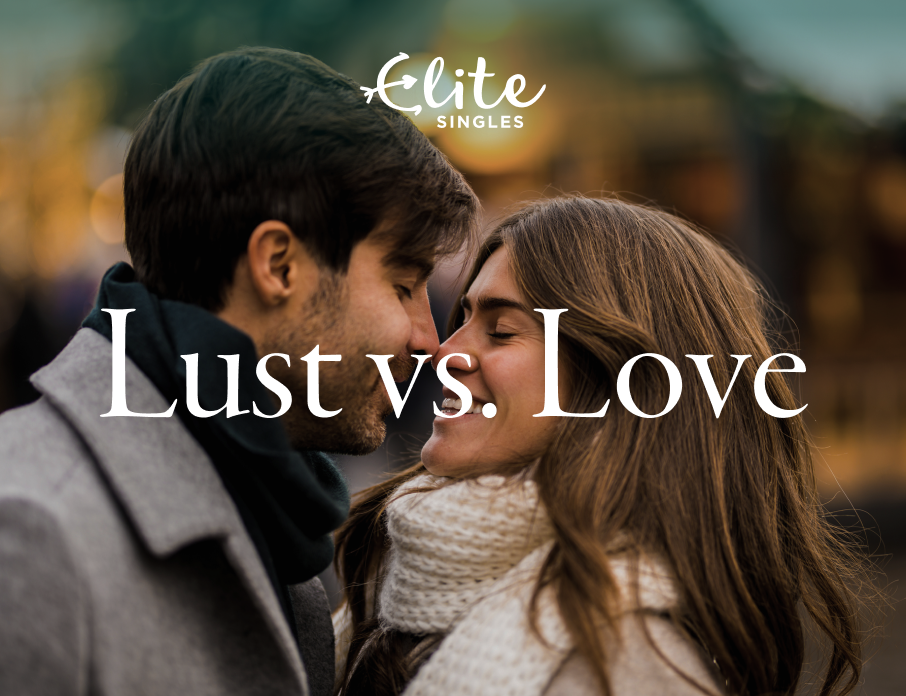Women seeking women for the long haul: you’ve come to the right place. EliteSingles is a serious online dating platform uniting like-minded American singles.
Discovering the distinction between lust vs. love isn’t always a straightforward task. During the first few months of a relationship, figuring out these two powerful emotions can be challenging, especially since both sensations often feel overwhelming. However, there are some common indicators to look out for that can help determine whether it’s love or lust.
To help you untangle the carnal impulses from true love, we’ve put together an extensive guide to lust vs. love. In this article, we’ll outline the definitions of these two concepts, look at some common signs of each, the main differences to watch out for, and more!
Defining Lust vs. Love
First off, and before jumping into the differences between love and lust, it’s worth defining the two terms we’re talking about. From there, you’ll be better placed to work out what it is you’re feeling.
What Is Lust?
So, what does lust mean? Mirriam-Webster’s definition of lust describes it as “intense or unbridled sexual desire.” While this is a reasonable description, it doesn’t quite cover all the bases that fall under the concept of lust. There are a few other powerful emotions that can also be present.
For example, lust can also describe a person who experiences a fervent desire to have something. It might be disproportionate and often involves yearning for something (or someone) excessively. Having the urge to control the situation is often prevalent, too.
5 Common Signs of Lust to Look Out For
Getting to grips with the concepts of lust vs. love can be tricky without knowing a few of the key signs to look out for. To get you started with this, we’ve put together five common signs of lust in a man and signs of lust in a woman to know about!
1. Your thoughts about them are always sexual: If every thought you have about the person immediately turns in some way to their body or physical intimacy, it’s a surefire indication of lust or even infatuation.
2. You’re desperate to kiss them: Is kissing the first thing you want to do as you see one another? If so, it could be a sign of lust.
3. Plans always revolve around sex: People who experience lust tend to always make plans that focus on physical intimacy.
4. You don’t have a lot in common: A focus on physical intimacy typically requires couples to have less in common than in a relationship built on love.
5. The conversation isn’t that meaningful: Lust doesn’t focus much on forming a deep connection with someone and so if there’s not much talk of the future, or the conversation never stems into deep topics, it’s a sign that it might be lust rather than love.
What Is Love?
There’s plenty of literature on demystifying love out there. But, the Oxford English Dictionary’s definition of love describes it as feelings of “deep affection or fondness for someone, typically arising from a recognition of attractive qualities, from natural affinity, or from sympathy.”
Love typically doesn’t have as much of an association with the instability that lust is fabled for. We often equate being in love with reliability and emotional intensity that delves deeper than a relationship focused solely on physical attraction. Even the very thought of losing love is unimaginable too.
5 Common Signs of Love to Look Out For
Similarly to lust, some typical things might indicate feelings of love. Check out five of the most common signs of love below!
1. Attraction goes beyond the physical: When you fall in love with someone, you’ll likely experience emotional attraction alongside the physical side of things.
2. You share everything: Whether it’s upcoming challenges, plans for the future, or something you’re feeling vulnerable about, a common sign of love is the willingness to share everything with a partner.
3. You can imagine a future with them: Similarly, being in love usually means being able to envision a long-term future together.
4. You enjoy, and look forward to, meeting their friends and family: If this feels like something to look forward to, rather than a dreary chore, it’s a common sign of love rather than lust.
5. Both sides are willing to put the work in: A common sign of love is a relationship whereby both sides are equally focused on fixing arguments and finding compromises that make each partner feel safe and happy.
What Are the Differences Between Love and Lust?
Even when you’re aware of the signs, spotting those love and lust differences isn’t always easy. After all, if there’s such a gulf between lust vs. love, how can you differentiate the two when in the throes of a passion? Below, we’ve outlined some of the key differences between love and lust to help you figure things out.
Attraction
In relationships characterized by lust, physical appearance is usually the overriding priority. Connections tend to be all about gratification and short-term pleasure, leaving room for little else. Love on the other hand usually centers more on good communication, cooperation, comfort, security, and trust.
Time
Lust is usually fast-paced but short-term while love is typically a slower starter — since it takes time to form a real, meaningful connection — but lasts longer.
Feelings
A relationship based on love is usually a bit harder to come by but once found, is more fulfilling on a deeper, emotional level. Lust, however, is all about that immediate, short-term gratification and can involve some emotional unavailability.
Dynamics
Lust tends to be more of a selfish concept whereas love involves dedicating time and energy to a partner and helping to make their life as rewarding and fulfilling as possible.
Is It Love or Lust? How to Tell What You’re Feeling
When it comes to lust vs. love, the two concepts aren’t always mutually exclusive. If you’re not sure how to define your relationship — or are struggling to figure out what it’s based on — there are a few questions you can ask yourself to work out whether it’s love or lust.
1. What do I want from this relationship? Are you just in it to spice up your sex life? Or are you genuinely interested in getting to know the person on a deeper level, willing to commit to them even when sex is off the table?
2. Am I willing to put in the work? Good relationships require commitment, hard work, and a willingness to go through those difficult conversations. Are you up for that?
3. Can I see a future with this person? If you’re in love, it’s likely you’ve already had thoughts about what the future might look like with your partner. If not, it might be lust rather than love.
4. Is the relationship getting better and more exciting with time? Although relationships based on love tend to be slow burners, they usually get more exciting over time as you get to know each other more deeply. Feelings of lust, however, often fizzle out after that short-term gratification.
5. Do I feel safe and secure in the relationship? If it’s a connection formed on love rather than lust, you should feel safe when you’re with your partner.
6. Do I want to introduce my partner to family and friends? If you’re not sure about this, and only feel like you want to introduce them to your bedroom, then it’s probably lust rather than love.
7. How would I describe the relationship? Consider how you’d tell someone about the relationship if you were asked. Would your description focus on how things are in the bedroom? Or would you describe your partner as someone who feels like your best friend?
Can Lust Turn Into Love?
The short answer here is – absolutely! It’s common for a relationship to start with a flurry of passionate lust that focuses heavily on the physical side of things. In relationships where lust turns into love, this initial wave of physical intimacy then develops into something deeper.
But, it’s worth remembering that experiencing that initial flurry of lust doesn’t always guarantee long-term compatibility and a move toward love.
Can Love Turn Into Lust?
Yes, for couples who’ve been together for a long time and are in love, it’s possible to re-ignite that spark and experience lust. In these cases, the couple might choose to do things to spice up the relationship. This could be anything from trying new things in the bedroom to couples therapy. In this regard, a relationship based on love can regain characteristics of lust later down the line.
Can We Experience Lust and Love at the Same Time?
When it comes to the topic of lust vs. love, this is a common question. According to Justin Lehmiller, PhD — a social psychology and award-winning educator — the two concepts aren’t necessarily exclusive. He states, “While you can experience love without lust or lust without love, it’s possible to experience both at the same time.”
Lust vs. Love: The Bottom Line
Determining the age-old conundrum of lust vs. love can be tricky at times. Both are valid, powerful emotions and you’re certainly not alone if you’re feeling unsure about what you’re experiencing.
What’s important is that you take the time to do some self-reflection and practice self-love. Consider the common signs of both concepts and ask yourself the questions above. In doing so, you’ll be well on your way to figuring out whether it’s love or lust and on the right path toward a deeper connection and a meaningful, lasting relationship!



